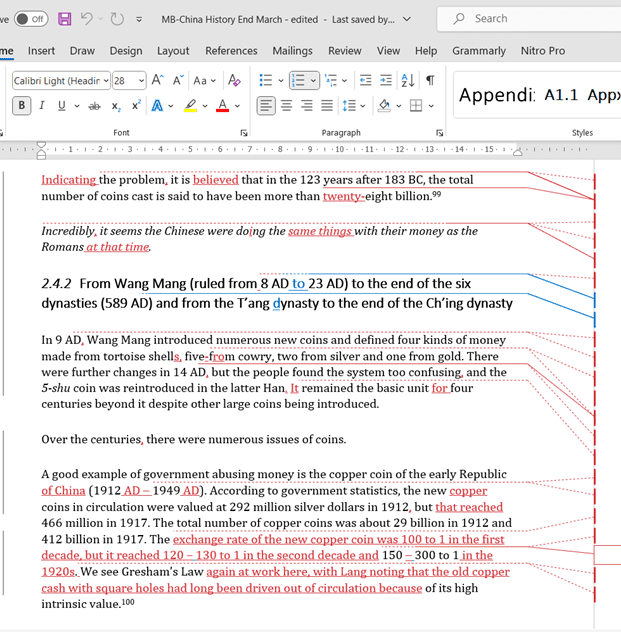Copy Editing: What does a copy editor do?
Many people are confused by the differences between copy editing and proofreading. The work of a copy editor includes much more than correcting grammar and punctuation. So let’s look at copy editing (sometimes called line editing) using examples to show what a copy editor does to improve a document and prepare it for publication.
Definition of copy editing
The Australian Style manual for authors editors and printers defines copy editing as follows:
The purpose of copy editing is to remove the mistakes, inconsistencies or other infelicities of expression that could irritate or confuse readers—or embarrass the author. At the copy editing stage, the editor therefore concentrates on the details of language, spelling and punctuation; on achieving consistency of style and layout; and on checking references, illustrations tables, headings, sequences, links, and preliminary matter and end matter.
The scope of copy editing services
The Style manual broadly defines copy editing tasks in four areas: language, consistency, references and functionality. This requires good attention to detail.
When copy editing language, the copy editor will find and correct errors in grammar, spelling and punctuation. In addition, the copy editor will look to improve clarity. In some instances, the copy editor might feel that the work needs substantive editing or should be sent back to the author for rewriting.
Copy editing for language consistency
When you do a copy edit for language consistency it requires more than knowledge of correcting punctuation and making grammatical corrections. The copy editor needs to ensure the publication is consistent throughout. Copy editing for consistency covers a wide range of elements, such as terminology, spelling, capitalisation, hyphenation, shortened forms, quantitative information, and style and tone.
Let’s look at some of these.
There are quite a few words that can be spelled in two or more ways correctly. If we were publishing an article about copy editing, for example, we would want to use the same spelling (copy editing) throughout. Depending on the dictionary you use, the term can also be spelled copy-editing and copyediting. Another example is online, which can also be spelled on-line (although this version was more common in the early days of the internet).
One of the tasks of a copy editor is to choose which spelling to use and make it consistent throughout the document. Some organisations will have a style sheet that shows the preferred spelling of common words. Publishing houses and universities usually have a preferred dictionary (such as Macquarie or Oxford in Australia) that should be used when choosing between alternative spellings.
Copy editing for consistency covers the small details (that many writers don’t think about) such as dashes. For example, the Style manual for authors, editors and printers suggests that em dashes (long dashes such as this —) be used as follows to set apart an explanatory phrase in a sentence.
National policies may change the decision-making environment—water licensing reform is an example—or provide guidance on suitable areas for government investment.
These and other types of dashes are often used incorrectly and inconsistently throughout documents. Copy editors find examples, such as the following, and correct them to ensure consistency.
National policies may change the decision-making environment – water licensing reform is an example – or provide guidance on suitable areas for government investment.
National policies may change the decision-making environment – water licensing reform is an example – or provide guidance on suitable areas for government investment.
Abbreviated forms often require correction for consistency during copyediting.
For example, in one section of a document the abbreviation of information technology, I.T., might include full stops (called periods in the USA), while in another IT doesn’t have full stops.
Many consistency issues are the result of collaborative efforts when different people or departments contribute to different parts of a publication. One person prefers to write IT, while another prefers I.T.
One way to prevent this problem—and make copy editing easier and less expensive— is to have a house style guide (also called a style sheet) that lists the preferred ways of spelling and abbreviating. You can also spell out general rules, such as ‘Abbreviations should not include full stops’.
Numbers are another factor that a copy editor needs to look at when copy editing. Do you spell out numbers as words or do you use numerals? The Australian Style Manual recommends using words for the numbers one through one hundred and writing higher numbers as numerals (when the document is not statistically oriented).
Bulleted lists are one potentially confusing element that an editor will correct to make consistent throughout a publication. Do you capitalise each bulleted point? Do you put a full stop or semi-colon at the end of each one? A copy editor will know the correct styles and apply them throughout the document (for more information on formatting bulleted lists see Editing and Proofreading: Bulleted Lists).
A fact check can be part of the copy editing process. While not the main goal of the copy edit, content editors can note things that don’t seem correct.
Copy editing for language and consistency is a time-consuming process. Besides checking and correcting spelling, punctuation and grammar, the copy editor needs to look for consistency throughout the document. A few of the elements that are checked for consistency during the copy-editing process are spelling, dashes, abbreviations, numbers and bulleted lists.
When calling on the services of a professional copy editor, it’s important to remember that a good copy edit requires more than checking for basic mistakes. The time and cost estimates you receive for copy editing services might seem high, but there is much more to the process than meets the eye. Also, it doesn’t pay to cut corners by sending your work offshore (such as to India or the Philippines) for editing. It’s unlikely that offshore editors will understand the style conventions used in your country, whether you’re in Australia, the UK or the USA. For example, in the USA, the Chicago Manual of Style is one of the main publications covering style conventions. However, there’s also the Associated Press (AP) Stylebook that doesn’t always match the Chicago Manual of Style.
Is content editing different?
The rise of social media and blog posts has led to a focus on content editing. While it’s a new term, the job for writers and editors has not changed. Readers still want to read news articles, creative writing and other forms of content that’s consistent and without grammar mistakes. So we can safely say that copy editing is a core part of content editing. There is a continued need for copy editors in any industry that requires writing, with it’s a short piece of writing for a business or a set of books in the book publishing industry.
Looking for a copy editor?
We’ve worked with hundreds of organisations since 2005. Contact us on 1300 731 955 or use the contact form on this page to discuss improving your documents and publications.



